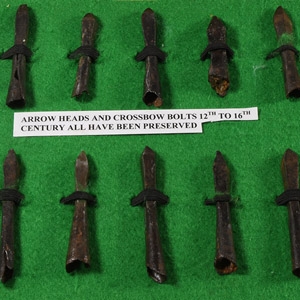Home > Auctions > 3 - 8 September 2024
Ancient Art, Antiquities, Natural History & Coins
Auction Highlights:
UK private collection before 2000.
Acquired on the UK art market.
Property of a London gentleman.
See Khorasani, M.M., Arms and Armour from Iran. The Bronze Age to the End of the Qajar Period, Tübingen, 2006, figures 454 and 455, p.741, for the type.
This type of arrowhead came in different varieties and sizes: some of them have barbed shoulders, some rounded shoulders, but both the types had a raised midrib.
From the collection of the famous author, writer and speaker, Gordon Bailey, Essex, UK; formed since 1968.
Bailey, G., Detector Finds 5, Witham, 2002, p.61, fig.7 & 10, for two examples.
The distinction between the early medieval lance and spear is difficult, However the lance (or the javelin), normally employed by mounted warriors, had a small slender and stouter blade, and a short wider socket. Both the spear and javelins could be used as throwing weapons by the 14th-15th century light cavalry, like the Spanish Jinetes.
From a military inspired collection formed from the 1990s.
Cf. Arendt, W. I., Granaten des 13-14. Jahrhunderts, die an der Wolga gefunden sind, Zeitschrift fur Historische Waffen-und Kostumkunde, 11 (1926-8), p.42; cf. Arendt, W., Die Spharisch-konischen Gefasse aus Gebranntem Ton, ibid; cf. Ayalon, D., Gunpowder and Firearms in the Mamluk Kingdom, London, 1956, p.16.
The Arabs made good use of these weapons. Their efficiency was described in the account of the siege of Akka in 1189, given by the contemporary historian Ibn al-Athir. He tells how the Christians exercised their engineering skills and built mighty siege towers. The situation was hopeless for the defending Arabs until a man from Damascus showed up, because he knew how to produce Greek Fire: ‘To trick the Christians he first threw some vessels with naphtha and other things, which were not set on fire, upon one of the siege towers, and it was without power. The Christians...climbed the top of the siege tower...the man from Damascus waited until the contents of the vessels were spread all over. When the moment came, he threw a new pot, which was set on fire. In a few moments the fire was spread all over, and the siege tower was eaten up by the flames. The fire was spread in such a hurry that the Christians could not manage to climb down from the siege tower. Men, weapons, everything was eaten up by the flames.’
From a specialist collection of militaria, London, UK, collected 1990s onwards.
Accompanied by an academic paper by military specialist Dr Raffaele D'Amato, dated 15 July 2019 and titled 'Eastern Roman Empire - Greek Fire Bomb or Hand Grenade (μεσαίον kακάβιον) 9th-11th century AD'.
Cf. Arendt, W. I., Granaten des 13-14. Jahrhunderts, die an der Wolga gefunden sind, Zeitschrift fur Historische Waffen-und Kostumkunde, 11 (1926-8), p.42; cf. Arendt, W., Die Spharisch-konischen Gefäße aus Gebranntem Ton, ibid; cf. Ayalon, D., Gunpowder and Firearms in the Mamluk Kingdom, London, 1956, p.16.
Apart from the use of siphons or manual flame-throwers called cheirosiphona, special corps of Roman soldiers employed terracotta grenades, in the form of small jars, abundantly evidenced in archaeological excavations. They were called μεσαία kακαβιά or κυτροκακάβια where the former had a bulbous shape and the latter a more cylindrical form.
From a specialist collection of militaria, London, UK, collected 1990s onwards.
Accompanied by an academic paper by military specialist Dr Raffaele D'Amato, dated 15 July 2019 and titled 'Eastern Roman Empire - Greek Fire Bomb or Hand Grenade (μεσαίον kακάβιον) 9th-11th century AD'.
Cf. Arendt, W. I., Granaten des 13-14. Jahrhunderts, die an der Wolga gefunden sind, Zeitschrift fur Historische Waffen-und Kostumkunde, 11 (1926-8), p.42; cf. Arendt, W., Die Spharisch-konischen Gefäße aus Gebranntem Ton, ibid; cf. Ayalon, D., Gunpowder and Firearms in the Mamluk Kingdom, London, 1956, p.16.
Apart from the use of siphons or manual flame-throwers called cheirosiphona, special corps of Roman soldiers employed terracotta grenades, in the form of small jars, abundantly evidenced in archaeological excavations. They were called μεσαία kακαβιά or κυτροκακάβια where the former had a bulbous shape and the latter a more cylindrical form.
From a military inspired collection formed from the 1990s.
Accompanied by an academic paper by military specialist Dr Raffaele D'Amato, dated 15 July 2019 and titled 'Eastern Roman Empire - Greek Fire Bomb or Hand Grenade (μεσαίον kακάβιον) 9th-11th century AD'.
Cf. Arendt, W. I., Granaten des 13-14. Jahrhunderts, die an der Wolga gefunden sind, Zeitschrift fur Historische Waffen-und Kostumkunde, 11 (1926-8), p.42; cf. Arendt, W., Die Spharisch-konischen Gefäße aus Gebranntem Ton, ibid; cf. Ayalon, D., Gunpowder and Firearms in the Mamluk Kingdom, London, 1956, p.16.
Apart from the use of siphons or manual flame-throwers called cheirosiphona, special corps of Roman soldiers employed terracotta grenades, in the form of small jars, abundantly evidenced in archaeological excavations. They were called μεσαία kακαβιά or κυτροκακάβια where the former had a bulbous shape and the latter a more cylindrical form.
From the collection of the famous author, writer and speaker, Gordon Bailey, Essex, UK; formed since 1968.
Cf. Bailey, G., Detector finds, Witham, 1999, pp.93-95, for similar examples of Medieval spurs.
Bailey, G., Detector finds 5, Witham, 2002, fig.4, p.32, for the 13th century spur.
By the late 13th century A.D., rowel spurs in the West had virtually replaced the old single prick point type spur. The rowel spurs were more effective as a goad and at the same time less damaging to the flank of the horse.
From the collection of the famous author, writer and speaker, Gordon Bailey, Essex, UK; formed since 1968.
Cf. Mills, N., Medieval Artefacts, Witham, 2003, pp.90-91, nos.243, for similar swallowtail arrowhead.
Mills, N., Medieval Artefacts Witham, 2003, pp.90-91, for two (nos.NM241a; NM242;).
Crossbow and bows were the protagonist of the 100 Years War between France and England. The crossbow, a bow fixed at its centre to a wooden stock, was a formidable weapon used by the Genoese crossbowmen, mainly in French service; its heavy bolt could easily penetrate a shield or armour breast plate at close range. The longbow, mainly used by the Welsh archers, was able to pierce armours at greater distance. During the reign of Edward III, the long bow distance was estimated to be 400 yards. The capability of the English and Welsh archers enabled the English to secure a victory over the powerful French Cavalry at the battles of Crecy, Poitiers and Agincourt.
Property of the vendor's grandfather, thence by family descent, circa 1985.
From the private collection of a New York, USA gentleman.
See Arkhipova, E.I., Videyko, M., Yu, V.I., Klochko, L.S., Klochko; Levada, M.E.; Simonenko, O.V., Stoyanov, R.V., Collection of antiquities of the Platonov and Tarut families (in Ukrainian), Kyiv, 2004, fig.8a, p.126, for a similar buckle.
Belt plaques with zoomorphic motifs illustrate not only the recognised unity of the zoomorphic art of the steppes, but also the links between the Sarmatians and the eastern nomadic groups. Important in this respect are similar buckles with representations of camels (Krasnogorovka III, Kurgan 11) or Ordos-style bronze plaques from the Kuban.
From the family collection of a Maida Vale lady, UK.
From the collection of the famous author, writer and speaker, Gordon Bailey, Essex, UK; formed since 1968.
Cf. Bailey, G., Finds identified, Witham, 2000, fig.19, p.86, for similar.
The crossbow, a bow fixed at its centre to a wooden stock, was a formidable weapon reintroduced in Western Europe in 11th century A.D.; it was used by the Genoese crossbowmen, mainly in French service, during the 100 Years War; its heavy bolt could easily penetrate a shield or armour breast plate at close range.
Ex London, UK, collection, 1990s.
1141 - 1152 of 3369 LOTS

.jpg)

.jpg)
.jpg)
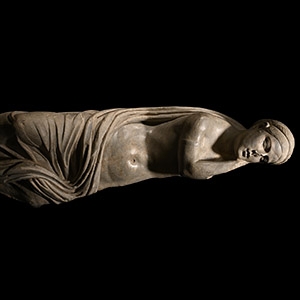
.jpg)
.jpg)

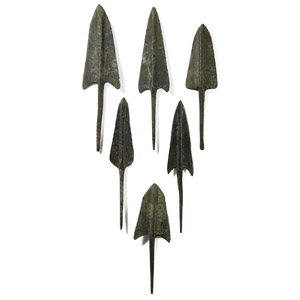
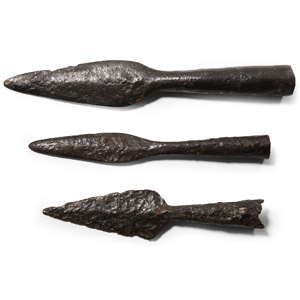
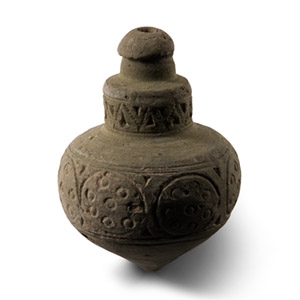
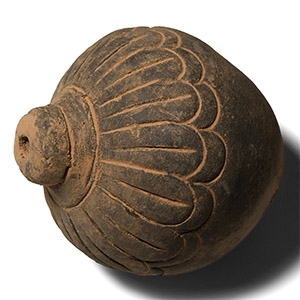
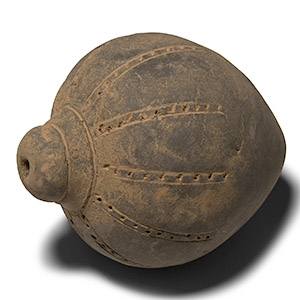

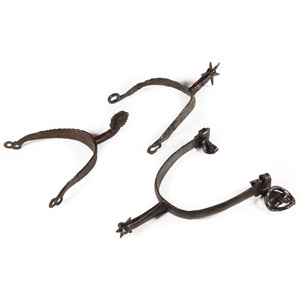
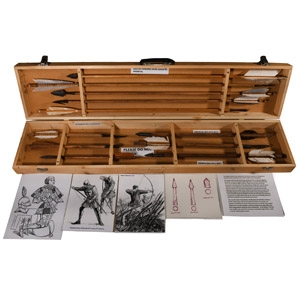
.jpg)

